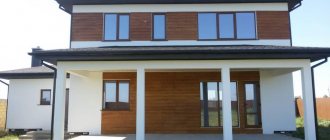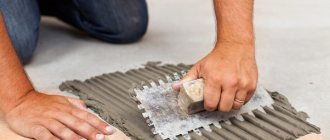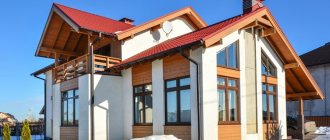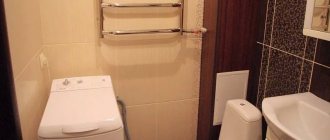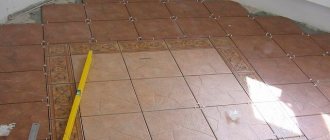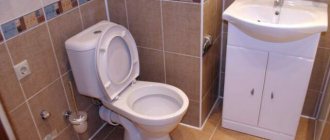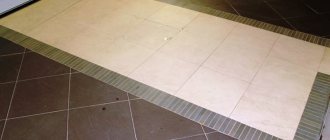Clinker tiles are a fairly popular material for finishing facades today. The walls of a house can be made of completely different materials. The building turns out to be aesthetically attractive, insulated if necessary, and the walls do not lose their ability to breathe. Products can be mounted in one of several ways, which differ in the need for additional layers. The cladding of external walls can be carried out according to the principle of a ventilated facade. There is no need to unstitch the seams after completion of the work.
What are clinker tiles for facades?
Facade clinker tiles are a material for exterior finishing that withstands frost and temperature changes well. It is based on environmentally friendly raw materials. The products are wear-resistant and durable. They have low water absorption and low operational requirements.
Traditionally, this type of finish contains clay, and you can recognize the product by its sound—by tapping the surface a little. The tiles are made by firing raw materials, which allows the material to obtain its unique properties.
The thermal conductivity of the products is quite insignificant and amounts to 0.021 W/(m K), and the density reaches 55 kg/m3. Finishing the facade of a private house with clinker tiles can be done using different materials, including:
- wood;
- brick;
- concrete.
Properties of clinker
The advantage of the material comes from the peculiarities of its production - firing at high temperatures. Thanks to it, clinker is the most durable compared to other types of brick. It is not negatively affected by moisture and temperature changes.
If you compare clinker with ordinary bricks or tiles, it has the highest mechanical strength. It is characterized by excellent compressive and flexural strength, and the tile surface is much more resistant to abrasion. An equally important property is low water absorption (from 1 to 6% by weight), which is explained by the density of the structure. Thanks to this, the material is frost-resistant. It is better to choose products with compositions based on shale clay, without harmful additives.
Let us highlight one more positive property - a high level of vapor permeability, which makes the material optimal for arranging a multi-layer facade.
Main types of clinker tiles
The described brick tiles can be classified according to several criteria. Among the main varieties are:
- heat resistant;
- facing;
- technical;
- moisture resistant.
One of the most popular is technical clinker. It is based on clay and a minimal amount of additives. A special requirement is placed on facing products, as they must have the most attractive appearance. If you need to finish an area that is exposed to increased moisture, you can use clinker tiles for the base. It has moisture-resistant characteristics and is characterized by reduced water permeability. The structure has small pores, the tile retains its original geometric parameters even with constant contact with water, in addition, it is frost-resistant.
Tile price criteria
Clinker finishing material is found in construction stores at prices ranging from 700 to 3,500 rubles per 1 m2. The cost varies depending on the texture and quality of the slabs.
The finished product may have a different appearance, depending on the mineral composition of the clay. If the product contains a lot of iron, then the clinker is characterized by terracotta shades. If carbon is added, the tiles are black and blue-gray.
Figure 6. Types of clinker tiles.
The key advantage of clinker tiles is their wide design possibilities. Manufacturers offer various imitation options: brick, polished stone or antique walls. The shape also varies: the materials can be rectangular, have rounded corners or uneven chips.
If work experience is not enough, it is recommended to contact specialists. In Russia, there is a “YouDo” service, where the customer specifies a list of works, after which he receives a proposal with prices for finishing from the craftsmen.
What is the difference between clinker facade tiles and other types?
When finishing a façade with clinker tiles, a material is used that does not imitate brick, but in fact is brick. This is the main difference between such products and other varieties. The decor has only a less impressive thickness; it is also distinguished by the method of installation, because the installation is carried out on a frame.
Additional distinguishing features are durability and strength. Since the raw material is exposed to high temperatures during the production process, it acquires the qualities of strength and ability to withstand the effects of water that are characteristic of natural stone. Clinker tiles for facades cope well with mechanical impacts; dents and scratches do not appear on its surface.
Another distinctive feature of the described finish is its wide range of applications. The products are used not only for the facade, but also for paving paths, lining pools, stairs and steps. The material does not mold, and its operating conditions can be the most difficult. All this makes this material one of the only possible solutions in some cases.
Facade thermal panels new clinker technologies
Facade thermal panels with clinker tiles are an excellent option for those who want to provide home insulation and get an attractive facade. The quick installation and good thermal insulation properties of such finishing have led to the popularity of thermal panels for finishing both private and public buildings.
Clinker thermal panels have a huge range of colors
There is a wide range of such materials on sale, but they are all quite expensive. At the same time, they demonstrate an optimal price-quality ratio, since they do not require special care, do not absorb moisture and ensure installation in the shortest possible time.
Using clinker for the facade, the homeowner is guaranteed to receive a spectacular, solid, respectable exterior decor, and at the same time protection of the walls from mechanical influences and natural factors. With significant costs for such finishing, you can count on a long service life , which makes it profitable in the long term.
Advantages and disadvantages
Clinker brick tiles have many advantages, but are not without their disadvantages. In addition to the above positive properties, it can be noted that the finish has a uniform tone, copes well with chemical influences and is wear-resistant.
Clinker tiles for facades can be selected from a wide variety of colors, textures and shades. Products can have completely different formats, which makes the appearance of the house unique.
An important factor when choosing a finish for a facade is the ease of maintenance of the material. Brick-like facing tiles are also good because they do not attract dirt and are easy to clean. External walls do not fade over time, as the decor is UV resistant. Laying is quite simple, and you can do it yourself without spending money on the services of professionals.
Facade clinker slabs seem to be good in everything, but, of course, they also have their drawbacks. One of the main disadvantages is the high cost, but the high cost is quickly justified by the excellent performance characteristics. The consumer may also be frightened by the impressive cost of adhesives and grouts, the first of which, however, may not be used during the installation process.
What is it for? Or how to carefully create a corner of a façade.
Clinker tiles are thin-walled bricks that are used for cladding the facades of buildings and, when executed correctly, completely create the feeling of a house built of brick.
In principle, a building faced with clinker bricks or a building covered with clinker tiles of the same color have no visual differences. But the weight of a whole brick is many times greater
than thin-walled tiles. And modern technologies make it possible to use facade tiles over a layer of reinforced insulation, thereby significantly increasing heat conservation inside the walls of the house.
If we choose thin-walled clinker tiles with a thickness of 8-21 mm, then the question will arise: how to make corners on a building or correctly design the slopes of window or door openings so as to fully correspond to the type of facing brick.
This is where corner clinker tiles come to the rescue , the format of which is produced by almost all self-respecting manufacturers.
Of course, window and door openings can be plastered
, bringing the ordinary elements flush with the corner.
They also sometimes use the method of cutting ordinary elements
at 45 degrees and bringing them together at an angle.
But to create a complete imitation of a brick wall, it is still recommended to use solid corner clinker tiles
. They will create a complete sense of the integrity of the façade.
As a rule, clinker tiles have a corner element that fully matches the color, format and model of the main material and has the same number and color name. In production, these corner elements are produced from the same clay batch recipe so that there is no color mismatch.
Corner clinker tiles have a higher price
than an ordinary one, and this is explained by the particular complexity of production: for this, a separate extrusion line is used that produces precisely these elements.
But believe me, the costs will be worth it:
façade projections, as well as external corners, window and door slopes, designed as a single inextricable element, will look much better than those combined from two row tiles. Using corner clinker tiles, the facade of your home will be immaculate.
In the descriptions of the manufacturers' assortment, we tried to indicate exactly the color schemes of this or that model; the price for corner elements is indicated in the price lists and they are always in stock.
More details You can get advice from our managers by phone
or you always have the opportunity to come to our showroom to see samples of these products.
Source of the article: https://www.roof-n-roll.ru/services/fasadnye-materialy/klinkernaya-plitka/montazh-klinkernaya-plitki/tipichnye-oblasti-primeneniya-klinkernaya-plitki/uglovaya-klinkernaya-plitka/
Specifications
One of the main characteristics of clinker tile decor is the almost complete absence of pores, which prevents moisture from penetrating inside. The room is waterproofed, and bacteria and mold do not form in the materials. Clinker tiles can endure up to 80 freezing and thawing cycles. In practice, this figure may be higher. Quite often, on this basis, comparisons are made with traditional brickwork. Although it is ready to serve for a long time, after two winters it is often covered with efflorescence.
The thickness of the clinker facade slab can reach 19 mm. The load per square centimeter can be one ton. If a finish is required to cover the stove, clinker decor is ideal, because it can have heat-resistant characteristics. The ability for steam penetration is limited to 0.05 mg/(m*hour*Pa). The number of closed pores in the material reaches 95%. One of the important characteristics is thermal conductivity. For a façade clinker slab, this figure is 0.021 W/(m K).
“Dry” method of finishing a facade with clinker
Dry is the method of cladding facades with clinker thermal panels. Fasteners for it are also sold complete with this finishing material. The panels are fastened to each other using structural locks at the ends of the products, and fastening to the base is done with self-tapping screws through the mounting holes in the tiles.
There are two methods of installing tiles: dry and wet
Corner thermal panels are produced for cladding corners, but their successful installation depends on the geometry of the building. Therefore, imitation of brickwork on slopes and corners of a building is often done by plastering and cutting seams after laying thermal panels.
The technology of finishing facades with temopanels is less labor-intensive and saves time, but the cost of such material is much higher than conventional clinker tiles.
Main manufacturing companies
Tiles for cladding a house should be selected not only according to their properties and technical characteristics, as well as appearance, but also by the manufacturer. Companies that have established themselves in the market supply products of guaranteed high quality. One of the companies is Feldhaus Klinker, which offers unglazed products with a rough surface. Clinker tiles under this brand have a texture that imitates facing brick.
The decor can also have an unusual look - like a stone. This one is manufactured and supplied by the Cerrad brand. Clinker tiles from this plant have not only traditional products, but also corner elements that make the laying process easier.
German quality has recently been especially appreciated by Russian consumers. This is confirmed by Stroeher products, for which the manufacturer provides a 25-year guarantee. Products of an unusual pearl shade are supplied to the market by Roben. The manufacturer managed to achieve this effect thanks to the use of white clay in the production process.
Pros and cons of panels
Experts and consumers highly appreciate the benefits of clinker panels. These include:
- high degree of strength;
- duration of service;
- providing thermal insulation;
- quick and easy installation;
- a huge range of design solutions;
- high wear resistance;
- versatility.
Proper strength of the material is achieved by manufacturing and design features. It is not afraid of direct contact with moisture and temperature changes, the occurrence of mold, and does not rot. The outer surface of clinker tiles retains its quality in any conditions for quite a long time. Polyurethane foam allows you to provide additional thermal insulation for your home, which will significantly save costs on coolants.
A significant advantage is the installation process. The finishing of the facade using clinker panels is carried out in a fairly short time, using common materials and tools. They are attached using nails, screws, staples and glue. The material is light, so it will not overload the walls of the house. Therefore, there is no need to worry about old buildings. They can easily be restored using clinker panels and made modern and attractive. In addition, the low weight eliminates any difficulties with transportation.
A wide variety of color solutions allows you to embody any design whim and give the appearance of your home originality. The resistance of clinker to ultraviolet radiation prevents color fading and allows you to maintain the original appearance of the finish for many years.
Against the backdrop of a huge number of all the advantages of the material, there is only one disadvantage - the high price. But it is justified if we take into account all its advantages.
Tips for choosing clinker tiles
Clinker facade tiles are selected based on several factors. You should pay attention to the color. It is divided into categories:
- dark colors;
- bright hues;
- yellow tones;
- brick color.
Color and design are usually the main selection criteria. Therefore, you should pay attention to the texture. She may be:
- shiny;
- rough;
- smooth.
As for the type of clinker, it can be represented by a traditional coating or in the form of a heat-insulating product.
Advantages and disadvantages
Clinker tiles are often chosen as a material for exterior finishing of a house. This is due to its technical characteristics. But clinker itself does not have thermal insulation properties, while products made from it in combination with insulation have won the market as an effective material for the exterior and interior decoration of buildings.
Before using panels for exterior finishing of a wooden house and other types of buildings, you need to familiarize yourself with the positive aspects of the products:
- They have high strength indicators.
- The service life is 25-30 years.
- Provide protection from cold penetration into the room.
- They feature improved sound insulation performance.
- They retain their color for many years, since there are no dyes in the raw materials. Different shades are achieved using certain types of clay and changes in baking technology.
- Withstands sharp fluctuations in ambient temperature.
- Do not become covered with mold and fungi, and are not attractive to rodents and insects.
- Safe for the environment and human health.
- They allow you to reduce heating costs by 40% due to the low thermal conductivity coefficient and the absence of joints.
- Easy to install. You can insulate a house faster due to the fact that the panel contains both insulation and cladding, so there is no need to first install a thermal insulation layer and then a decorative layer.
- Universal, as it is suitable for different buildings.
- If you choose a curtain façade, you can hide any wall defects.
- They have an attractive and respectable appearance and enhance the façade.
- Do not get wet and are resistant to steam.
- In case of mechanical damage to the area, the panel can be easily replaced.
- Suitable for all types of bases.
- They have high fire safety ratings.
- They don't freeze.
- Favorable price when compared with other systems for thermal insulation of a building.
- Resistant to precipitation.
Due to such impressive characteristics, the cost of the material is higher than that of other types of facade finishing, as is the price of work per m2.
Clinker thermal panels also have several disadvantages. Professionals and users argue that the weight of the products is large, so their installation requires additional strengthening of the façade and foundation, and the panels can be easily damaged during transportation. If you drop them from a small height, they will crack or burst. Therefore, the manufacturers' instructions contain information that they must be handled with care.
Tile laying technology
Finishing the base with clinker tiles follows the same principle as in the case of cladding external walls. The direction of laying can be any, but you need to start from the bottom. In order to obtain seams between products, plastic crosses should be used. The traditional pitch is 10 mm.
The same technology is used to cover the stove or walls in the kitchen. It involves applying glue to both surfaces. The composition is distributed using a notched trowel. The directions of the strips should be transverse. As soon as the tile is on the surface, it is lightly pressed and begin to move from side to side. The position of the cladding should be checked using a building level.
Preparing the façade surface for installation
Before installation begins, a thorough inspection of the walls is carried out and they are prepared for further work. Here, different options are possible, depending on the type of wall material and the general condition of the facade.
Preparations for installation directly on the wall
This option is possible if the walls are made of:
- concrete,
- aerated concrete,
- bricks with a plaster layer.
The main requirement is the solidity of the base for the tiles, without any weak points - shedding, cracks, peeling, looseness, etc. All unreliable areas must be cleaned and repaired by applying a reinforcing adhesive composition.
Features of cutting clinker tiles
In order for the lined surface of a stove or facade to look attractive, it is necessary not only to correctly install the finishing, but also to cut it. For this we use:
- manual tile cutters;
- Bulgarians;
- roller glass cutters;
- tile cutters;
- hole saws for special purposes;
- hacksaws for metal with a diamond wire.
Since tiles, although highly durable, may exhibit characteristics of fragility. If the material is purchased in limited quantities, it should be cut with extreme caution. If cutting technology is not followed, products may break and crumble, and the edges may end up with chips and cracks.
The easiest way to cut clinker tiles is with a manual tile cutter. With its help, the edge turns out to be aesthetic and smooth. But the process is quite labor-intensive, and large amounts of work will be difficult.
Attention! In order to facilitate the cutting process, you need to apply a few drops of machine oil to the cutting wheels, then it will be easier to cut and the cutting line will be cleaner. To carry out work, markings must be applied to the surface of the product with a marker or pencil.
The tile is adjusted so that the wheel matches the markings. Using the handle, you need to move the wheel along the surface. In this case, the product must be fixed, and after a light blow on the handle of the tool, you can get the desired fragment of the tile.
Types of clinker ceramics
Depending on the area of application, facing clinker is produced in the following types:
- technical - for paving roads;
- facing – for external finishing of facades and other surfaces;
- waterproof - for cladding bases that are in long-term contact with water (swimming pools, saunas, baths);
- special - for performing complex artistic decoration.
Clinker tiles vary in size, color and surface texture
In relation to the finishing of facades, we will consider facing clinker ceramics, which, in turn, is divided into:
- tiles;
- thermal panels.
Clinker tiles are a product made of baked clay, uniform throughout its entire thickness, laid on a base using tile adhesive.
A clinker thermal panel is a multilayer finishing tile consisting of a front clinker layer and a base insulation. Thermal panels are produced in the size of one tile or in the form of a fragment of several clinker products on a common base. The thickness of the thermal panel can be from 4 to 8 cm.
Features of the furnace lining
If you have stove equipment in your home, you can decorate it using clinker tiles. Its installation is carried out using a special adhesive solution with heat-resistant characteristics. The composition is distributed using spatulas, including flat ones. It is this one that is used first, then its toothed counterpart is used.
The glue layer can be anything, but the optimal value is about 6 mm. The mixture is applied not only to the reverse side of the finish, but also to the surface of the stove. This will allow you to achieve more impressive adhesion of materials. If you use clinker tiles in interior design, this will make the room colorful and the finished surface durable.
Correction of the position of the tile is carried out within a few minutes after gluing it. Excess composition coming out of the seams is immediately removed. Installation work must begin from the corners. You should retreat 1 cm from the floor surface. This gap is necessary for thermal expansion of the finish.
Attention! The furnace lining can be carried out using different laying schemes. If this is a diagonal arrangement, you should be prepared for the fact that there will be more scraps, therefore, the material consumption will be higher.
After 2 days, you can begin grouting the seams between the products on the surface of the oven. To do this, you should use exclusively heat-resistant grout, which is selected according to the shade of the tile. The composition is applied with a rubber spatula.
Grouting joints
In order to grout the seams between the tiles, you should prepare materials and tools in advance
Has its own characteristics. After the glue has slightly hardened, use a special thin spatula to remove it from the seams and clean the surfaces of any glue residue. Start grouting no earlier than three days after installation, otherwise the tiles may become damaged and will have to be re-glued. Prepare the grouting solution taking into account the manufacturer’s recommendations; we described above which brand to choose. It should be semi-dry in consistency.
Place a little mortar on a trowel or any flat surface; to seal, you need to have a long, narrow tool the width of the seams.
Trowel or trowel for jointing or grouting clinker tiles
Lean the trowel against the wall, pick up small portions of the thick mortar with the tool and carefully seal the seams. Level their surfaces at the same time.
Practical advice. It is much faster to first seal several rows of vertical seams, and then horizontal ones. At the same time, remove the difference in height between them.
Colored grouting mixture (fugue) for clinker tiles
Joining with a trowel
Vertical seams are easier to open with a smaller spatula
The picture shows the grouting
When opening seams with a trowel, you can create various optical elements
This method of semi-dry grouting significantly reduces contamination of the front surface of clinker tiles. Final cleaning is done with an ordinary brush.
Brushing the seam with a brush gives it the appropriate structure
Type of finished seam
It is not recommended to use seams that are not completely filled, as moisture and dirt collect in them.
If you have sufficient skills, then you won’t have to use a damp sponge; the work will be done neatly and beautifully. If not, then the problem areas will have to be wiped. But remember that the surface of clinker tiles is easy to dirty, but difficult to clean. After drying, the stains will appear again, the procedure will have to be repeated several times.
According to the surface grouting method, the seams are sealed using a jointing or plaster lath
After drying, the remaining grout is removed from the tile with a sponge using movements at 45 degrees to the tile
Using a plaster lath with a sponge, wash off the excess solution diagonally
Finished look
